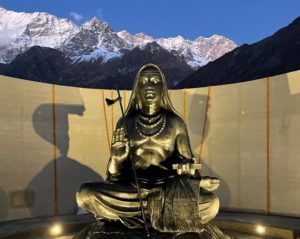Published on: November 6, 2021
ADI – SHANKARACHARYA
ADI – SHANKARACHARYA
NEWS
Prime Minister Narendra Modi unveiled a 12-foot statue of Adi Shankaracharya at Kedarnath, where the acharya is believed to have attained samadhi
 ABOUT ADI SHANKARA
ABOUT ADI SHANKARA
- Born in Kaladi village, Kerala on banks of river Periyaar
- In one legend, a crocodile caught hold of the young Shankara while bathing in the Periyar, and told his mother it would let him go if she allowed him to take sanyas.
- In a lifespan of just 32 years, he is said to have visited all the important spiritual centres of the time — from Kanchi (Kancheepuram) to Kamrup (Assam), and Kashmir and the Kedar and Badri dhams, as well as Sringeri, Ujjain, Kashi, Puri, and Joshimath.
- Established four Math (Monastery) at Shingeri, Puri, Dwaraka and Badrinath– for propagation of Sanathana Dharma.
- Established the ritual practices at the Badri and Kedar dhams, and to have debated with tantrics in Srinagar.
- Identified as the author of 116 works — among them the celebrated commentaries (bhashyas) on 10 Upanishads, the Brahmasutra and the Gita, and poetic works including Vivekachudamani, Maneesha Panchakam, and Saundaryalahiri.
- His biography – Shankaravijayas (Conquests of Shankara)
SHANKARA’S ADVAITA VEDANTA
Shankara’s great standing is derived from his commentaries of the prasthanatrayi (Upanishads, Brahmasutra and Gita), where he explains his understanding of Advaita Vedanta
ESSENCE OF ADVAITA
- Articulates a philosophical position of radical nondualism, a revisionary worldview which it derives from the ancient Upanishadic texts
- Upanishads reveal a fundamental principle of nonduality termed ‘brahman’, which is the reality of all things
- Brahman is transcending individuality and empirical plurality.
- Essential core of one’s self (atman) is brahman
- Atman is pure non-intentional consciousness.
- One without a second, nondual, infinite existence, and numerically identical with brahman.
- Entails tying a metaphysics of brahman to a philosophy of consciousness

